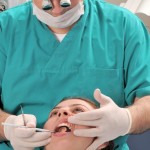
Oral disorders, principally caries and periodontal disease are common worldwide and represent a significant health and economic burden on patients, health care systems and society. Routine examinations contribute a substantive element of costs and there has been a debate over the clinical and cost-effectiveness of the frequency of the routine dental examination (check-up) for at least four decades (Sheiham 1977). While the principle clinical component of the check-up is to detect caries and periodontal disease, oral soft tissue examination for oral cancer and medical and social history are also key element. Although there is no universally recognised definition of ‘the dental check-up”
The aim of this Cochrane review update was to determine the optimal recall interval of dental check-up for oral health in a primary care setting
Methods
Searches were conducted in the Cochrane Oral Health’s Trials Register, the Cochrane Central Register of Controlled Trials (CENTRAL), Medline, Embase, the US National Institutes of Health Trials Registry (ClinicalTrials.gov) and the World Health Organization International Clinical Trials Registry Platform for ongoing trials with no restrictions on the language or date of publication. Only randomised controlled trials (RCTs) assessing the effects of different dental recall intervals in a primary care setting were considered. Standard Cochrane review methodology was followed.
Results
- 2 RCTs involving a total of 1736 patients were included.
- 1 study was considered to be at low risk of bias the other at high risk.
24-month versus 12-month recall at 2 years’ follow-up
- Due to the very low certainty of evidence from one trial, it is unclear if there is an important difference in caries experience between assignment to a 24-month or a 12-month recall.
- For 3- to 5-year-olds the mean difference (MD) in dmfs increment =0.90(95%CI; −0.16 to 1.96) [58 patients].
- For 16- to 20-year-olds, the MD in DMFS increment =0.86(95%CI; −0.03 to 1.75) [127 patients].
Risk-based recall versus 6-month recall at 4 years’ follow-up
- We found high-certainty evidence from one trial of adults that there is little to no difference between risk-based and 6-month recall intervals for the outcomes:
- number of tooth surfaces with any caries (ICDAS 1 to 6); MD=0.15(95%CI; −0.77 to 1.08) [1478 patients];
- proportion of sites with gingival bleeding MD= 0.78% (95%CI; −1.17% to 2.73%; 1472 patients);
- oral-health-related quality of life MD (OHIP-14 scores) = −0.35 (95%CI; −1.02 to 0.32; [1551 patients].
- There is probably little to no difference in the prevalence of moderate to extensive caries (ICDAS 3 to 6) between the groups RR= 1.04(95%CI; 0.99 to 1.09; 1478 patients; moderate-certainty evidence).
24-month recall versus 6-month recall at 4 years’ follow-up
- We found moderate-certainty evidence from one trial of adults that there is probably little to no difference between 24-month and 6-month recall intervals for the outcomes:
- number of tooth surfaces with any caries MD= −0.60(95%CI; −2.54 to 1.34; [271 patients];
- percentage of sites with gingival bleeding MD= −0.91%(95%CI; −5.02% to 3.20%; [271 patients].
- There may be little to no difference between the groups in the prevalence of moderate to extensive caries RR= 1.05 (95%CI; 0.92 to 1.20; [271 patients; low-certainty evidence].
- We found high-certainty evidence that there is little to no difference in oral-health-related quality of life between the groups MD (OHIP-14 scores)= −0.24(95%CI; −1.55 to 1.07; [305 patients].
Risk-based recall versus 24-month recall at 4 years’ follow-up
- We found moderate-certainty evidence from one trial of adults that there is probably little to no difference between risk-based and 24- month recall intervals for the outcomes:
- prevalence of moderate to extensive caries RR= 1.06(95%CI; 0.95 to 1.19; [279 patients];
- number of tooth surfaces with any caries MD= 1.40 (95%CI; −0.69 to 3.49; [279 patients].
- We found high-certainty evidence that there is no important difference between the groups in the
- percentage of sites with gingival bleeding MD= −0.07% (95%CI; −4.10% to 3.96%; [279 patients]; or in
- oral-health-related quality of life MD (OHIP-14 scores)= −0.37 (95%CI; −1.69 to 0.95; 298 patients).
Conclusions
The authors concluded: –
For adults attending dental check-ups in primary care settings, there is little to no difference between risk-based and 6-month recall intervals in the number of tooth surfaces with any caries, gingival bleeding and oral-health-related quality of life over a 4-year period (high-certainty evidence). There is probably little to no difference between the recall strategies in the prevalence of moderate to extensive caries (moderate-certainty evidence).
When comparing 24-month with either 6-month or risk-based recall intervals for adults, there is moderate- to high-certainty evidence that there is little to no difference in the number of tooth surfaces with any caries, gingival bleeding and oral-health-related quality of life over a 4-year period.
The available evidence on recall intervals between dental check-ups for children and adolescents is uncertain. The two trials we included in the review did not assess adverse effects of different recall strategies.
Comments
This review updates a version first published in 2005 and updated again in in 2007 and 2013( Dental Elf-24th Jan 2014). The current version includes data from the recently completed INTERVAL study. This high quality UK primary care-based study has enabled the review authors to update their conclusions, so providing moderate to high-certainty evidence for adults that there is little or no difference in caries, periodontal disease and oral‐health‐related quality of life outcomes if dental recalls are provided every 24 months, or at shorter intervals based on the dentist’s judgement, rather than every 6 months. However additional evidence is needed in relation to children and adolescents.
Links
Primary Paper
Fee PA, Riley P, Worthington HV, Clarkson JE, Boyers D, Beirne PV. Recall intervals for oral health in primary care patients.Cochrane Database of Systematic Reviews 2020, Issue 10. Art. No.: CD004346. DOI: 10.1002/14651858.CD004346.pub5.
Other references
Cochrane Oral Health Blog – How often should you see your dentists for a check-up?
Sheiham A. Is there a scientific basis for six-monthly dental examinations? Lancet. 1977 Aug 27;2(8035):442-4. PubMed PMID: 70653.
Dental Elf – 24th Jan 2014
